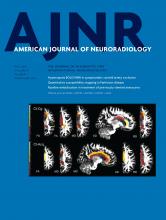Article Figures & Data
Tables
Indications for MR Imaging No. Ventricular dilation at US 34 Midline malformation at US 20 Posterior fossa anomalies at US 17 CMV infection 14 TTTS 14 Cysts at US 2 Vascular malformation at US 2 Brain anomalies in previous pregnancy 2 Cortical malformations at US 1 Toxoplasma infection 1 Polymalformation at US 1 Brain edema at US 1 Note:—TTTS indicates twin-to-twin transfusion syndrome; CMV, cytomegalovirus.
Malformation No. Midline malformations Complete callosal agenesisa 10 Callosal hypoplasia 9 Partial callosal agenesis 3 Septum pellucidum agenesis 2 Incomplete septum pellucidum 1 Fused thalami 1 Occipital meningocele 1 Disorders of cortical development Focal polymicrogyria 5 Heterotopias 3 Hemispheric polymicrogyria 2 Anomalous sulcations not of polymicrogyria typeb 2 Arrhinencephaly 1 Schizencephaly 1 Posterior fossa anomalies Vermian hypoplasia 6 Cerebellar hypoplasia 4 Vermian counterclockwise rotation 4 Malformed brain stem 2 Chiari type I malformation 1 Molar tooth malformation 1 Beaking of the tectum 1 Vascular malformations Persistent falcine sinus 2 Dural sinus malformation 1 Ventricular/subarachnoid space anomalies Ventricular dilation 32 Ventricular and pericerebral space dilationc 6 Dysmorphic ventriclesd 6 Pericerebral space dilation 4 ↵a Median diameter of the atrium of the lateral ventricles: 11 mm (range, 9–12 mm).
↵b Dysmorphic gyration pattern, for example, large areas of shallower or deeper sulci without evidence of abnormally small and packed gyri.
↵c Pericerebral CSF space was considered enlarged when the difference between the right-left brain and skull diameters was >10 mm.29
↵d Ventricular shape anomalies, mostly of the frontal horns (On-line Fig 4).












